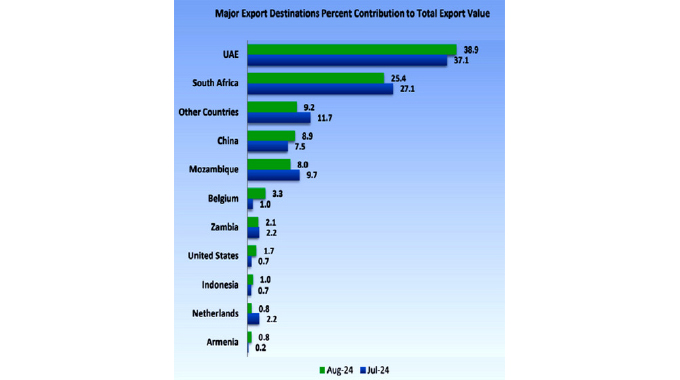Zimbabwe’s total export value rose by 22.9% in August 2024, reaching US$674 million, up from US$548.3 million the previous month, driven by strong performance in minerals and tobacco, according to official data.
The Zimbabwe National Statistics Agency (ZimStat) reported a 27.7% decrease in the trade deficit during this period, dropping from US$274.9 million in July to US$198.7 million in August.
Notable exports included semi-manufactured gold (37.9%), tobacco (13%), and nickel mattes (9.8%), with ferrochrome and coal also contributing significantly.
The primary destinations for Zimbabwe’s exports in August were the United Arab Emirates (38.9%), South Africa (25.4%), and China (8.9%), collectively accounting for about 73% of the country’s total export value. The UAE has rapidly become one of Zimbabwe’s largest trading partners, especially for minerals and horticultural products, having not appeared in the top 10 export destinations before 2017-2018.
Zimbabwe’s imports for August totaled US$872.8 million, marking a 6% increase from US$823.2 million in July. Major sources of imports included South Africa (41.4%), China (14.9%), Mozambique (5.4%), and the Bahamas (4.7%), which together comprised around 66% of the total import value.
ALSO READ: Two Fishermen Who Went Missing Found Dead at Lake Chivero
The leading categories for imports were mineral fuels, oils, machinery, cereals, vehicles, and fats and oils.
Supported by the National Development Strategy 1 (NDS 1), ZimTrade aims to boost total exports by at least 10% annually, targeting US$14 billion by 2030. Last year, the value of Zimbabwe’s exports increased nearly 10%, reaching US$7.2 billion, up from US$6.59 billion in 2022.
Furthermore, ZimTrade highlighted that the implementation of the African Continental Free Trade Area (AfCFTA) agreement presents significant opportunities for Zimbabwe to explore new export markets. In the previous year, Zimbabwe’s exports to African countries amounted to US$3.1 billion.
The AfCFTA, which Zimbabwe signed, became operational on January 1, 2021, marking a pivotal step toward continental economic integration. The country has ratified the agreement, positioning itself to engage fully in the US$3.4 trillion trading bloc, the largest single market in the world, encompassing approximately 1.3 billion people. Zim’s Export

For comments, Feedback and Opinions do get in touch with our editor on WhatsApp: +44 7949 297606.


